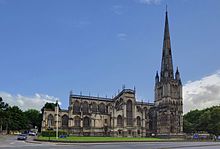St Mary Redcliffe
| St Mary Redcliffe | |
|---|---|

St Mary Redcliffe from the north
|
|
| 51°26′54″N 2°35′24″W / 51.4482°N 2.5899°W | |
| Location | Redcliffe Way, Bristol, BS1 6NL |
| Country | England |
| Denomination | Church of England |
| Previous denomination | Roman Catholic Church |
| Churchmanship | Broad Church/Liberal Catholic |
| Website | Church website |
| Architecture | |
| Status | Active |
| Functional status | Parish church |
| Style | Perpendicular Gothic |
| Completed | 15th century |
| Specifications | |
| Length | 240 ft (73 m) |
| Width | 44 ft (13 m) |
| Nave width | 59 ft (18 m) |
| Height | 54 ft 9 in (16.69 m) |
| Spire height | 292 ft (89 m) |
| Administration | |
| Parish | St. Mary Redcliffe with Temple Bristol and St. John the Baptist, Bedminster |
| Deanery | Bristol South |
| Archdeaconry | Archdeaconry of Bristol |
| Diocese | Diocese of Bristol |
| Province | Province of Canterbury |
| Clergy | |
| Vicar(s) | The Revd Dan Tyndall The Kat Campion-Spall (Associate Vicar) |
| Honorary priest(s) | The Revd Peter Dill The Revd Canon Neville Boundy The Revd Canon John Rogan The Revd Canon Michael Vooght |
| Laity | |
| Director of music | Andrew Kirk |
| Organist(s) | Claire Alsop, Graham Alsop |
| Churchwarden(s) | Marion Durbur and Richard james |
| Verger | Matthew Buckmaster (Head Verger), Carys Underdown, Andy Carruthers |
| Parish administrator | Pat Terry |
St. Mary Redcliffe is an Anglican parish church located in the Redcliffe district of Bristol, England. The church is a short walk from Bristol Temple Meads. The church building was constructed from the 12th to the 15th centuries, and it has been a place of Christian worship for over 900 years. The church is renowned for the beauty of its Gothic architecture and is classed as a Grade I listed building by Historic England. It was famously described by Queen Elizabeth I as "the fairest, goodliest, and most famous parish church in England."
Little remains of the earliest churches on the site although a little of the fabric has been dated to the 12th century. Much of the current building dates from the late 13th and 14th centuries when it was built and decorated by wealthy merchants of the city whose tomb and monuments decorate the church. The spire fell after being struck by lightning in 1446 and was not rebuilt until 1872. Little of the original stained glass remains following damage in the English Civil War with extensive new glass being added during the Victorian era. The tower contains 15 bells designed for full-circle English-Style change ringing. Other music in the church is provided by several choirs and the Harrison & Harrison organ.
The first church on this site was built in Saxon times, as the Port of Bristol first began. In medieval times, St. Mary Redcliffe, sitting on a red cliff above the River Avon, was a sign to seafarers, who would pray in it at their departure, and give thanks there upon their return. The church was built and beautified by Bristol's wealthy merchants, who paid to have masses sung for their souls and many of whom are commemorated there.
Parts of the church date from the beginning of the 12th century. Although its plan dates from an earlier period, much of the church as it now stands was built between 1292 and 1370, with the south aisle and transept in the Decorated Gothic of the 13th century and the greater part of the building in the late 14th century Perpendicular. The patrons included Simon de Burton, Mayor of Bristol, and William I Canynges, merchant, five times Mayor of Bristol and three times MP. In the 15th century Canynges' grandson, the great merchant William II Canynges, also five times Mayor and three times MP, assumed responsibility for bringing the work of the interior to completion and filling the windows with stained glass. In 1446 much of this work was damaged when the spire was struck by lightning, and fell, causing damage to the interior; however the angle of the falling masonry and the extent of the damage is unclear. Although the spire was to remain damaged for the next 400 years, Canynges continued in his commitment to restore and beautify the church. He took Holy Orders after the death of his wife, and is buried in the church. Other families associated with St Mary Redcliffe include the Penns, the Cabots, the Jays, the Ameryks and the Medes.
...
Wikipedia
